Archive for ‘Storage Products’ Category
Reference Files Master Class (Part 1) — The Essentials of Paper Filing
COPING WITH PAPER OVERWHELM
After last week’s post, Paper Doll Shares 12 Kinds of Paper To Declutter Now, I had a number of readers mention to me that while knowing what to get rid of helps them deal with their paper piles, they were still sometimes at a loss as to what to do with the rest.
Some fear they should be scanning everything to keep it digital, but don’t even own scanners. Others feel frustrated because even when they’ve arranged to get (and pay) their bills digitally, they still have paper coming to them. Many people feel at odds with the 21st-century pressure to have digital records, and don’t particularly feel adept with handling papers digitally. (They forget to look at email until it’s too late, or they never get around to scanning, or information just doesn’t seem “real” to them if it’s not in tangible form).
Over the 16+ years that I’ve been blogging as Paper Doll, I’ve tried to get across that whether you use analog or digital techniques — whether for paying bills, or keeping track of your appointments and tasks, or filing or archiving your information — doesn’t matter. That is, the method doesn’t matter; the commitment to a system is what is most important.
But 16 years is a long time. Babies born during the launch of my first Paper Doll posts are old enough to drive! To give you a sense of how long ago that was, Desperate Housewives was still a top-10 TV show (and people were still watching broadcast television). The top song was Crank That (Soulja Boy) and we were all trying (and mostly failing) to do the dance.
I originally wrote about the elements of a reference filing system in the first month of Paper Doll posts, back in 2007. It’s time to revisit the topic, see how digital solutions do (and don’t) help with the paper overwhelm, and introduce new readers to the best ways to manage paper.
Over the next several weeks, we’ll be taking a fresh look at how eliminate the frustration of paper files.
The Ice Cream Rule
The key to making any system work is just that — a system. That means having a location where something belongs and behavioral rules to get them there. I often refer to this as the Ice Cream Rule. If you come home from the store with two bags, one holding a half gallon of cream and one with a package of toilet paper, which one will you put away first? And where would you put them?
Even people who insist that they’re terrible with systems laugh and admit that they automatically know to put the ice cream away first; they recognize that they’ll end up with a melted mess if they do not.
They also have no worries that they’ll put the ice cream where they won’t be able to find it again — in the cupboard or the pantry — because their system not only includes behavioral cues (ice cream before toilet paper), but a geographic location (that is, the freezer) where the ice cream belongs.
Yes, people may drop the bag with the toilet paper on the kitchen floor, or hang it on the linen closet door, or actually put away the toilet paper in the bathroom right after getting the ice cream in the freezer.
Admittedly, the behavioral part of putting away non-urgent items isn’t perfect. The squeaky wheel gets the oil, and when it comes to putting things away properly, ice cream’s urgency is squeakier than toilet paper. (That said, the retrieval of ice cream is likely to be less urgent.)
A HOME FOR YOUR REFERENCE FILING SYSTEM
The point, and I do have one, is that to create order with the paper in our lives, we must ensure that we know exactly where everything goes. How? Filing papers is easy once each item is assigned a place to live. All of your reference papers need to have a home.
Keep in mind, that home does not have to be a palace. You certainly can invest in filing cabinets. These range from bargain 2-drawer metal filing cabinets to office-style 4-drawer tower-style cabinets.
If you prefer lateral filing cabinets (where you stand to the side of the open drawer, rather than in front of it), there are a variety of styles and materials from which to choose.
Justick by Smead: Vertical Organizing Powered By Balloon Magic
Remember the first time you ever saw someone rub a balloon on his head and then stick the balloon to the wall? You were perhaps four or five years old, and it probably seemed like magic. At some point you learned it was static electricity, but if you’re being honest, doesn’t it still seem like magic?
Well, Smead’s newest answer to solving paper clutter with vertical storage pretty much runs on balloon magic.
JUSTICK BY SMEAD ELECTRO BULLETIN BOARDS
Last year, at the NAPO2016 conference in Atlanta, we got a sneak preview of the Justick by Smead collection, but this year in Pittsburgh, we got our official introduction to their new display boards. We viewed a desktop copyholder, the kind of item you’d usually use for displaying documents to give you easy access while typing at your computer. But look more closely at the Justick — and take a moment to appreciate the adorable tot on the left, the daughter of Smead’s Associate Marketing Manager Leiann Thompson. (Paper Doll is sending a shout-out to Leiann, soon to welcome tot #2 into the world!)
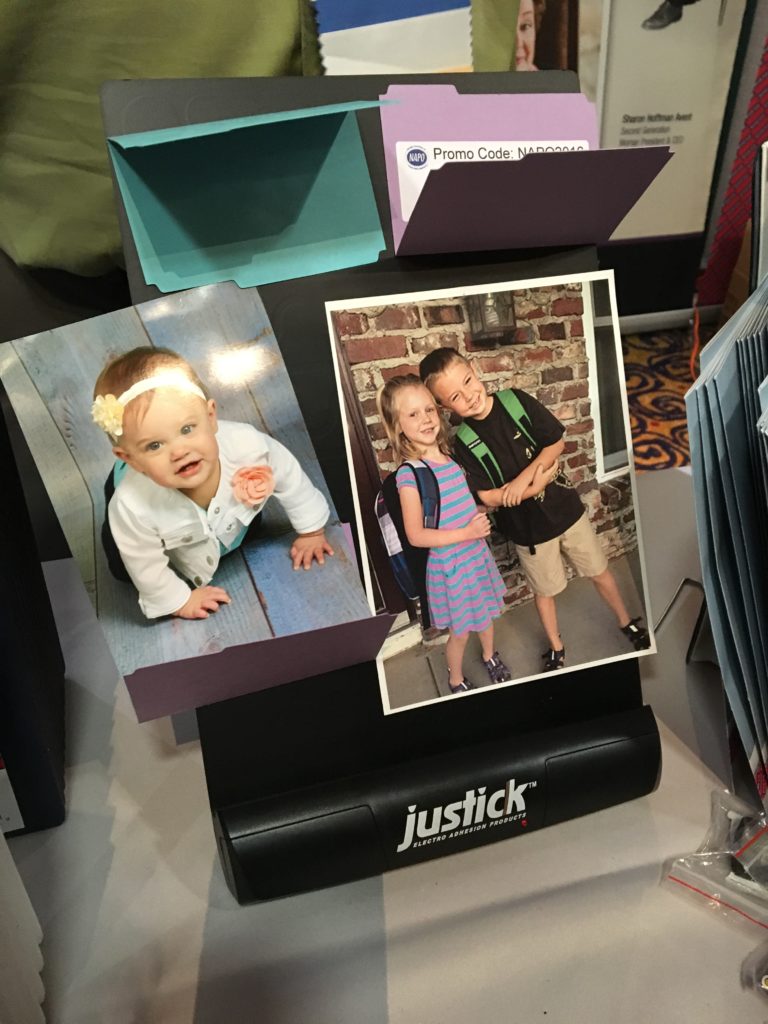 Can you tell that there’s nothing holding the photos to the copyholder? The photos and doodads adhere to the Justick as if by magic. Rather than needing push-pins, glue, magnets, tape, or that sticky roly-poly stuff used to hang posters, Smead has developed an advanced type of bulletin board that allows you to organize things vertically — using nothing but the power of static electricity!
Can you tell that there’s nothing holding the photos to the copyholder? The photos and doodads adhere to the Justick as if by magic. Rather than needing push-pins, glue, magnets, tape, or that sticky roly-poly stuff used to hang posters, Smead has developed an advanced type of bulletin board that allows you to organize things vertically — using nothing but the power of static electricity!
OK, officially, it’s electro-adhesion surface technology.
Justick’s technology keeps in place whatever you put on the board: photos, memorabilia, reminder notices, business cards, phone lists, illustrations, training material, etc., and does so vertically. And no, you don’t have to rub anything on your head to get it to stick.
The electrical energy behind the Justick boards is powered by four AA batteries, or you can use an optional AC adapter if you’d rather keep it plugged in. Justick products have modern aluminum frames and frameless styles, and there are a variety of display solutions within three main categories:
- Electro Bulletin Boards
- Dry-Erase Boards with Clear Overlays
- Commercial Communication Solutions
Justick Frameless Wall Strip Display
Start by hanging this simple, black, unobtrusive, 48″ W x 8″ H strip on your wall.
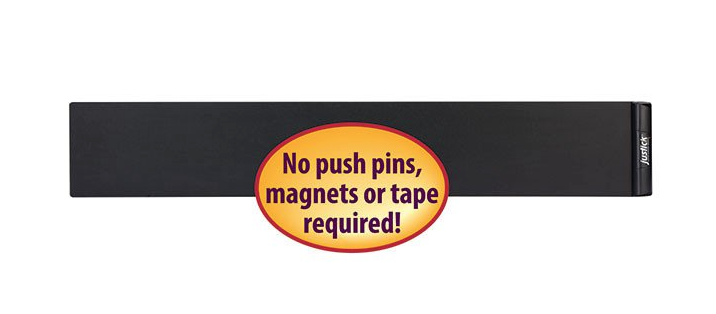
Next, grab anything you’d like to keep in front of your face, but off of your desk. Your toddler’s newest artwork? Up it goes. The business cards for the people you need to call this week? Display them in columns or rows. Birthday cards? Motivational photos of yoga positions? Whatever you’d like to see on your wall, without having to find studs, poke holes, or make anything sticky.
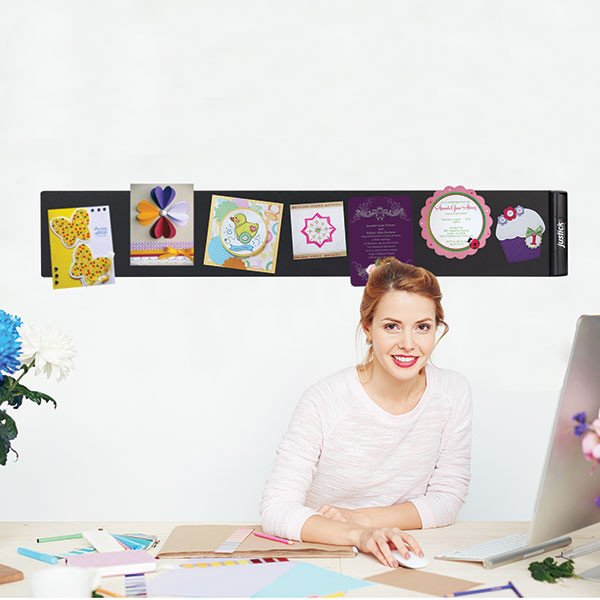
The Justick Frameless Wall Strip Display retails for $79.99 on Amazon, myOrganized.life and Office Depot.
Justick Frameless Desktop Organizer/Copyholder
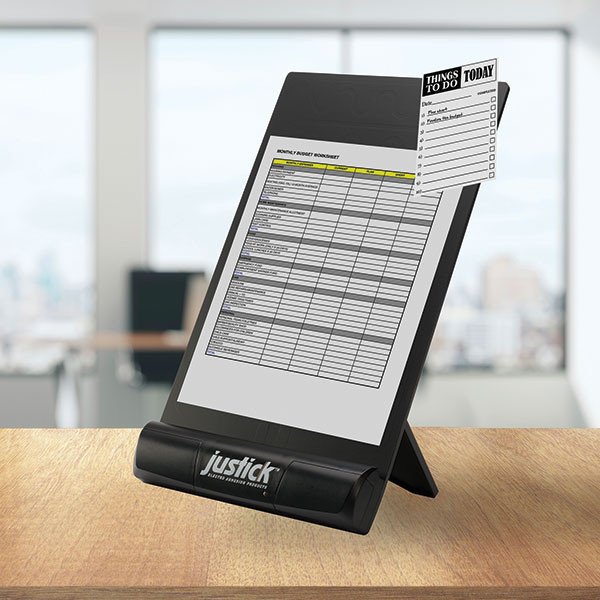
Ever since the days of the typing pool, there has been a need to stand papers vertically while doing your typing. Invariably someone gives you a printout or handwritten document when you’d prefer an email or link to Evernote, and it’s up to you to get the information into digital form. Arraying a document vertically makes it easier to move your eye from the paper to the screen and back again vs. having to keep looking down at your desk.
The neato-keen thing about the Justick version is that you can stick multiple items on at once — so you can keep multiple ad hoc (documents, contracts, to-do lists, etc.) items and more permanent ones (cheat sheets, department codes, etc.) on the same page. Paper Doll tested this out — things really do stick where you put them and, unlike balloon-style static electric power, they do not start sliding down to the floor or desk as time goes on.
The Frameless Desktop Organizer/Copyholder is black, measures 8″ W x 11″ H and is priced at $34.99 at Amazon, myOrganized.life, and Office Depot.
Justick Frameless Mini Electro Bulletin Board
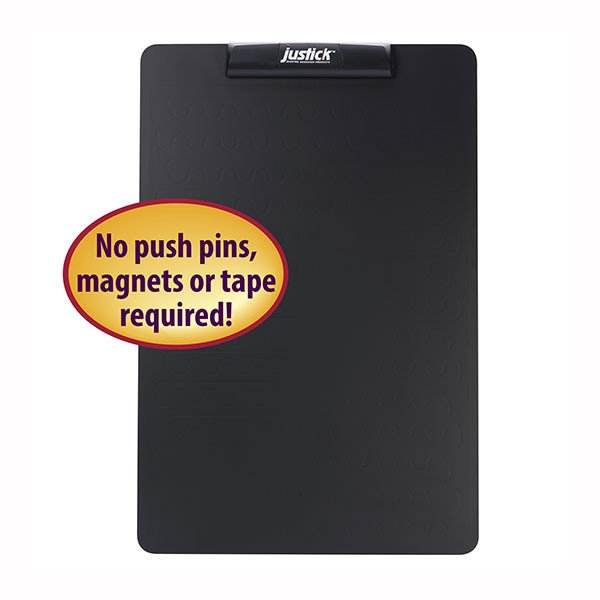
The “mini” bulletin board measures 16″ W x 24″ H, so it isn’t all that small except in comparison to its siblings, but it’s perfect for vertically displaying essential papers in homes and small offices.
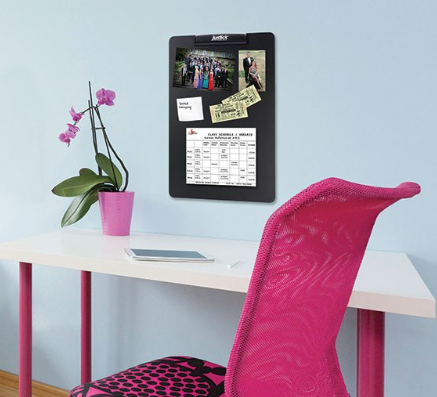
The mini runs $69.99 at myOrganized.life and Amazon.
Justick also has three versions of their framed full-sized electro bulletin boards. The boards for all have modern black styling, and both the standard and premium framed versions are three feet wide by two feet high, suitable for larger home offices and small businesses. The larger premium version, four feet wide by three feet high, is more suitable for larger businesses with ample display space.
- Standard Aluminum Frame Electro Bulletin Board, 36″ W x 24″ H ($79.99 at myOrganized.life or Amazon)
- Premium Aluminum Frame Electro Bulletin Board Black, 36″ W x 24″ H ($119.99 at myOrganized.life or Amazon)
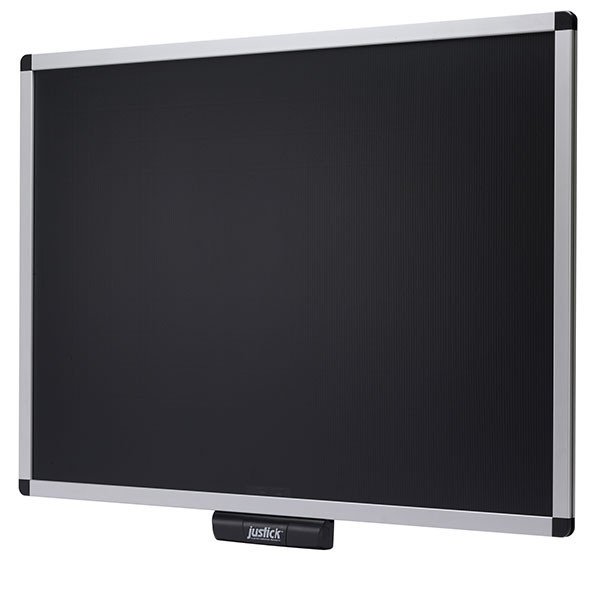
- Premium Aluminum Frame Electro Bulletin Board, 48″ W x 36″ H ($189.99 at Amazon or myOrganized.life), more suitable for office displays.
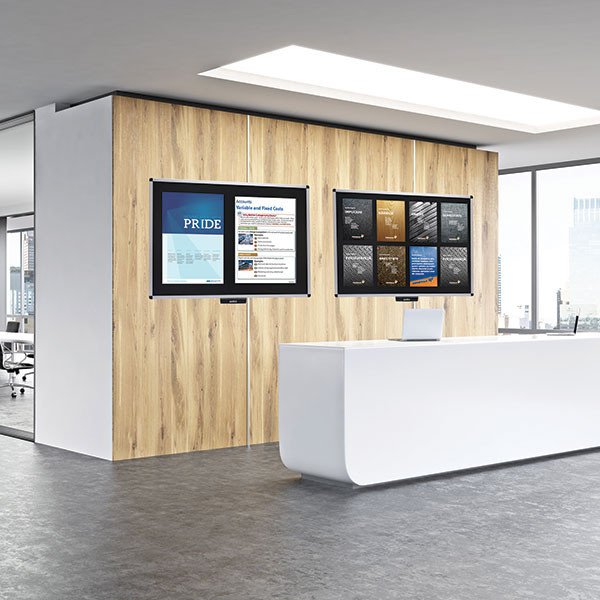
JUSTICK ELECTRO DRY-ERASE BOARDS WITH CLEAR OVERLAY
As discussed above, Justick provides an innovative alternative to a fussy French board in your home or corkboard in your office. But what about when you want a dry-erase board? Do you have wall space enough for both? Happily, you don’t need it, as Justick has also developed a combination electro-board with a clear dry-erase overlay, to serve both purposes.
As with the electro boards above, just install four AA batteries into the board, and the Justick electro surface technology transforms the surface from “zero adhesion” (that is, like any old “dumb wall”) into a powerful force field able to attract photos, papers, business cards, calendars, and memorabilia.
Use either dry-erase or wet-erase markers on your board to “write, display, and interact” with three times the benefit of a traditional board. The durable plastic overlay provides a clear, brilliant surface that Smead says won’t ghost or stain, creating a dynamic whiteboard experience with the utility of a bulletin board. However, as they say on the infomercials…
BUT WAIT, THERE’S MORE!
Smead has also developed Justick overlay board templates. Categories include:
- Education (for teaching addition, alphabet tracing, telling time, cursive writing, and more)
- Sports and Coaching (for teaching basketball, football, and hockey plays)
- Family Activities (daily calendar for activities)
- Home Management (grocery shopping planners, architectural design planning)
- Scheduling and Management (Gantt charts, goal tracking, sales reporting, weekly/monthly/yearly and project planners, and more)
- Medical Industry (hospital and clinic sign in/out, operating room schedules, patient information data for hospital rooms, etc.)
- Restaurant Management Industry (layouts for the day’s specials)
Got papers? Stick them up!
Got something you want to write or draw? Doodle it freehand or use a template! Get thee to it!
Whether you’re doing a presentation for your biggest client or teaching your child that “M” is for “Mommy” by moving a photo of yourself next to where you’re practicing the alphabet together, Justick has an option.
Justick Frameless Mini Dry-Erase Board with Clear Overlay
The Frameless Mini Dry-Erase Board comes in two versions, black or white, with a clear overlay. Both measure 16″ W x 24″ H and sell for $79.99 at Amazon and myOrganized.life.
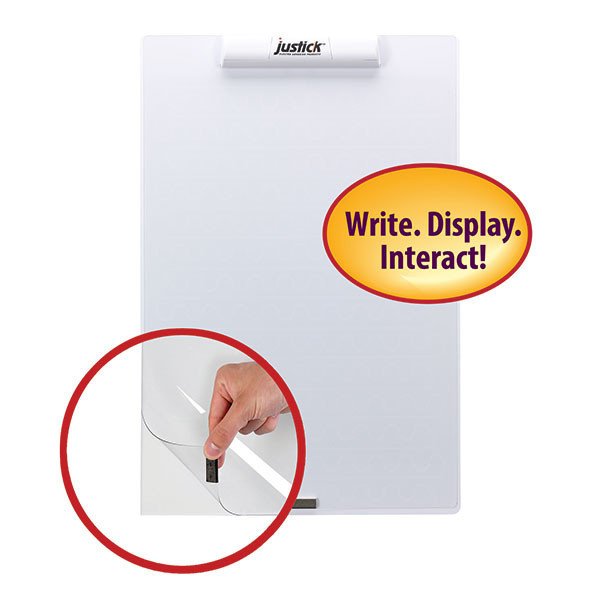
Premium Aluminum Frame Dry-Erase Boards with Clear Overlays
If you want something on a grander scale, for your home, school, business, or medical office, Justick has four full-sized dry-erase options, all with the same electro surface adhesion technology and erasable properties, in either black or white in each of two sizes, measuring 36″ W x 24″ H or 48″ W x 36″ H.
- Premium Aluminum Frame Dry-Erase Board, Black with Clear Overlay, 36″ W x 36″ H ($179.99 at myOrganized.life or Amazon)
- Premium Aluminum Frame Dry-Erase Board, White with Clear Overlay, 36″ W x 36″ H ($179.99 at my Organized.life or, right now, $152.39 at Amazon)
- Premium Aluminum Frame Dry-Erase Board, Black with Clear Overlay, 48″ W x 36″ H ($229.99 at myOrganized.life or Amazon)
- Premium Aluminum Frame Dry-Erase Board, White with Clear Overlay, 48″ W x 36″ H ($229.99 at myOrganized.life or Amazon)
JUSTICK ELECTRO COMMERCIAL COMMUNICATION SOLUTIONS
In addition to home and office bulletin board and dry-erase solutions, Justick also has a line of commercial display products suitable for larger businesses, restaurants, hospitals, non-profits, and other locations.
3-Panel Table-Top Expo Display
Picture yourself at the fanciest, most grown-up version of a science fair and you have some sense of how this Justick 3-Panel Table-Top Expo display works. At 72″ W x 36″ H, it allows you to set up your displays for conferences, expos, and whatever corporate version of Show & Tell at which you need to make a big splash, without fear that breezes, un-sticky sticky tape or lost push-pins will cause trouble. It’s priced at $399.99 at myOrganized.life (or $391.67 at Amazon) and can be carried securely in its own 36″ W x 27″ H nylon carrying bag ($99.99).
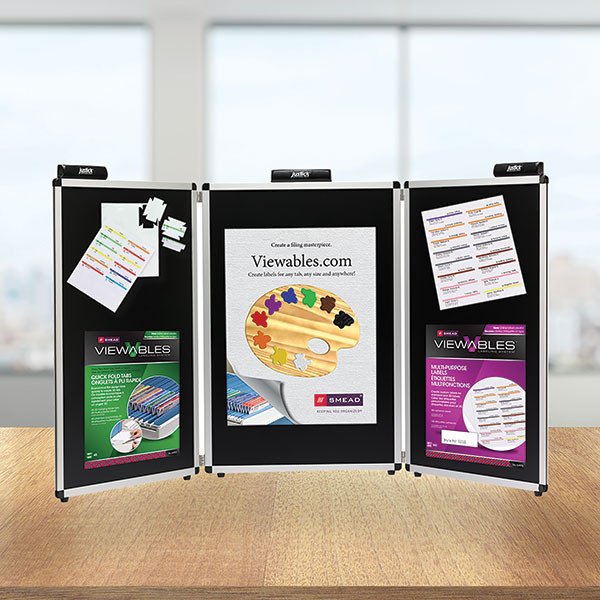
Lobby and Promotional Stands
Justick also makes a wide variety of lobby and promotional stands. They are all black with aluminum frames and have electro surface technology, but you can choose from standard or dry-erase versions for the lobby stands, and choose among single- and double-sided for the promotional stands, as well as a dry-erase version.
- Lobby Stand with Justick Electro Surface Technology, 24″ W x 36″ H ($249.99 at myOrganized.life or Amazon)
- Dry-Erase Lobby Stand with Clear Overlay, 24″ W x 36″ H, with Justick Electro Surface Technology ($299 at myOrganized.life and Amazon)
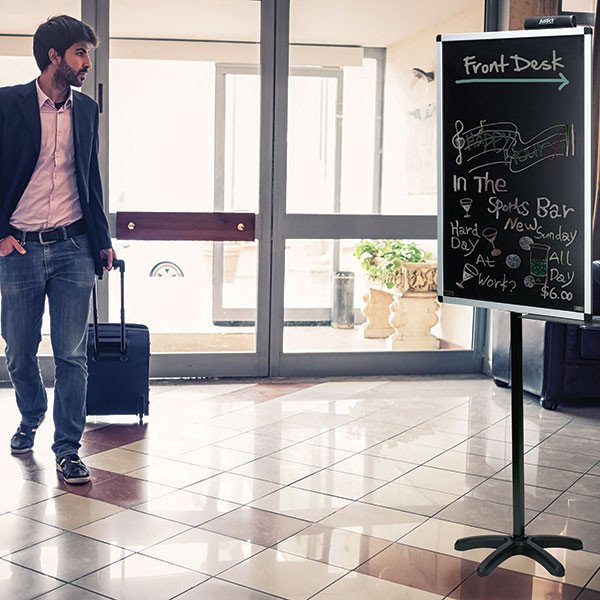
- Promo Stand Single Side, 24″ W x 36″ H, with Justick Electro Surface Technology ($350 at myOrganized.life or $350 at Amazon)
- Promo Stand Double Side, 24″ W x 36″ H, with Justick Electro Surface Technology ($375 at myOrganized.life or Amazon)
- Dry-Erase Promo Stand with Clear Overlay, 24″ W x 36″ H, with Justick Electro Surface Technology ($375 at myOrganized.life or Amazon)

Certainly, some of the higher-end Justick products are more than one would need in a home or small office, and I’d like to see some technology for making the wall-affixed products even easier to display. (Hmm, how about a partnership between Smead’s Justick and 3M’s Command brand of hooks and adhesives?) I’d also love to see some colorful options for the smaller items for use in dorm rooms.
So, why are these Justick products so intriguing?
First, it’s the balloon magic. The ability to make your papers and photos adhere to a vertical surface without having to rummage through your desk for thumbtacks or tape is an organizational advantage.
Second, for the dry-erase versions, it’s advantageous to be able to mix (temporary) storage and dynamic writing.
Third, it’s VERTICAL. As this blog has referenced previously, vertical storage is fabulous when your area is small, when your workspace is awkwardly laid out, and when you want to avoid building up clutter.
- Paper Doll Adjusts the Vertical Hold: Space-Saving File Solutions
- New Smead Organized Up Folders Stand At Attention
- Upright Expansion: Pendaflex® Vertical Reinforced Expanding Wallets and Files
- Up Filer: A New Vertical Filing Solution
- NAPO2014: Our Friends at Smead Are on the Up and Up!
Of course, vertical clutter isn’t completely impossible — I’m sure you’ve seen refrigerator doors with long-forgotten appointment card reminders, overdue notices, and invitations to events that have long-since past — all layered over one another until the door is almost double its original thickness. So, it’s still important to cull and purge your papers on an ongoing basis, whether they’re lying down or standing up.
Don’t you just love balloon magic?
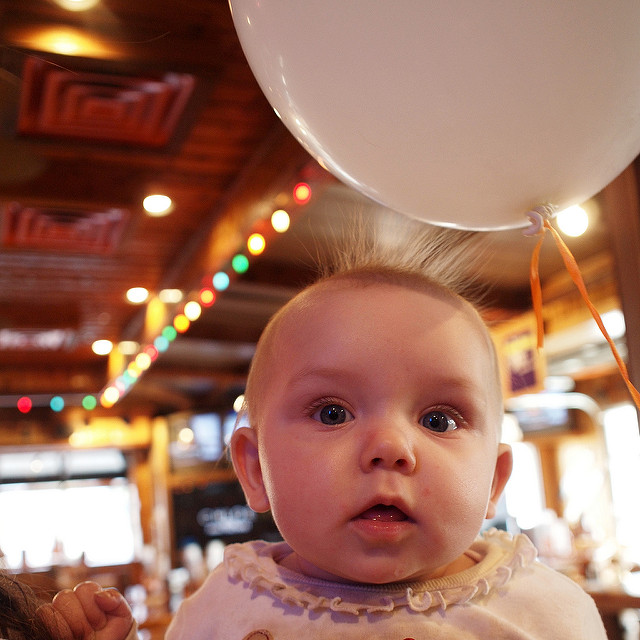
Photo of Bella+Balloon, courtesy of Pat David is licensed under Creative Commons 2.0
NAPO 2015: Origami & SOFI–Innovations for Organizing Your Home
People ask professional organizers about storage solutions all the time. What are the best containers for our possessions? What shelves or tubs or drawers or dividers or other magical tools should we buy to organize our stuff? Of course, that’s the wrong question, or at least the wrong first question. To me, focusing on the storage container instead of the contents is like buying an outfit and becoming determined to lose weight to fit into it.
The problem? When we set out to lose weight, we really have little idea (or control over) whether the weight lost will be in the bosom or the buttocks, the abs or the love handles. It makes much more sense to reduce the excess (of our stuff or our too, too solid flesh) before picking the perfect outfit, wrapper or container.
That said, the right storage container, in a pleasing style or color, can help us preserve order and keep us from backsliding into clutter. Today, we’ll explore two new product lines that displayed their storage solutions at the NAPO 2015 Annual Conference and Organizing Expo.
ORIGAMI
EXPO attendees were mesmerized at the Origami booth. As you may know, origami is the Japanese art of paper folding, an art with which I’ve had mixed results.
Think about what you detest most about putting shelves and racks together. The difficulty making sense of poorly translated directions? The need to buy weird one-time-use tools? The extra bits and pieces left over, leaving you fearing the whole thing will collapse?
Origami seeks to put those worries out of our heads by creating racks and shelves that are already fully assembled, folded and collapsed prior to packing, and require only a bit of “unfolding” to display their genius. No tools are required, and most of the products fold flat for easy storage.
To see how a basic Origami Rack comes together, take a peek at this video.
Origami has five product lines:
- Home Origami products includes racks, tables and organizers. The racks are suitable for mudrooms, bedrooms, pantries and living rooms, and also include decorative displays, folding closets and shoe racks.
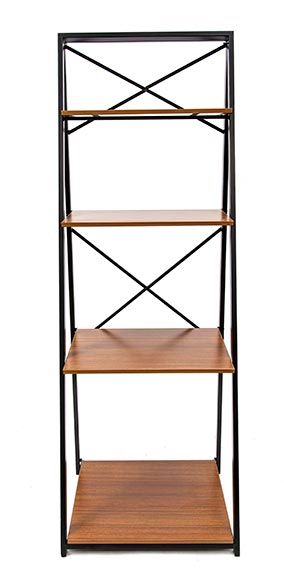 The basic table is just the right size for sewing, crafts or a small study desk. The metal/soft-side organizers work vertically and horizontally.
The basic table is just the right size for sewing, crafts or a small study desk. The metal/soft-side organizers work vertically and horizontally.
- Kitchen Origami products include a tall pantry rack, Baker’s rack, and a variety of kitchen carts.
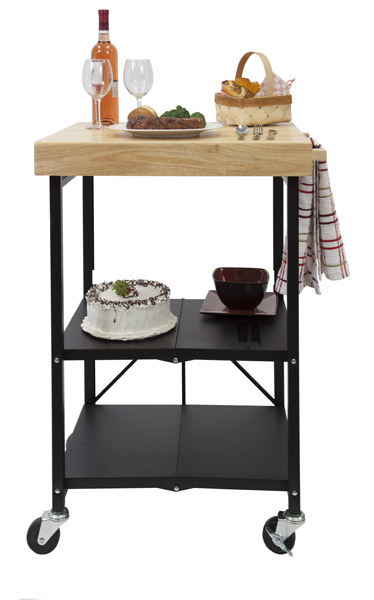
- Garage Origami racks come in multiple sizes, shapes and heights, and both with and without wheels, for everything from storeroom displays to corralling seasonal possessions.
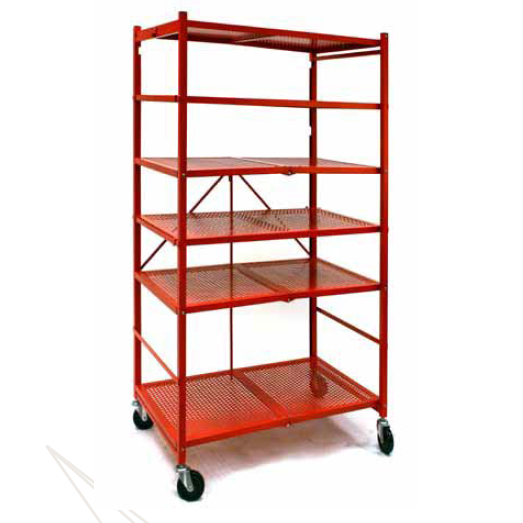 There are also small and full-size workbenches.
There are also small and full-size workbenches. - Garden Origami products include a 3-foot potting bench and a 4-tier greenhouse.
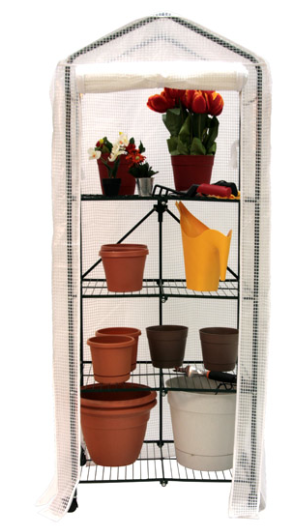
- Office Origami items include a six-tier bookshelf, a standard computer desk and a laptop trolley, as well as an intriguing folding trunk.
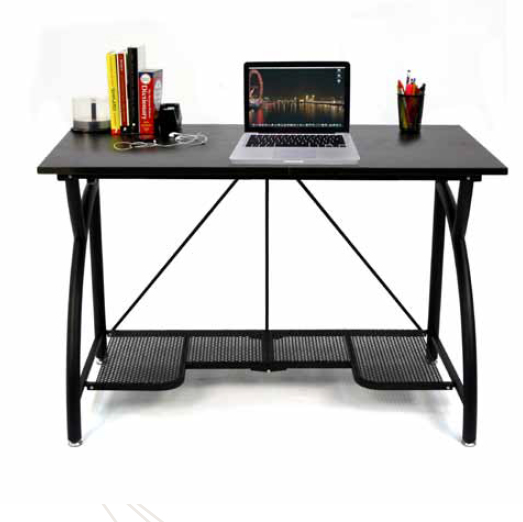
Other products, not shown on the Origami web site but included in the catalog distributed at the NAPO Expo, include an over-the-washer/dryer rack, additional general-purpose shelving units and bookshelves, a TV stand with extra tiers, and soft canvas rack and cart covers.
The Origami racks and other shelving items seemed impressively sturdy and easy to “unfold” into place; most of the shelves for the larger racks have a 250 pound weight-bearing capacity. (The pantry rack, computer desk and workbenches support 100 pounds; the laptop trolley, 50 pounds.)
Pricing for the various units ranges from $49.99 to $299.99, though the vast majority of items are under $150. Origami’s shelves, racks, tables and organizers are so new that there’s no distribution information readily available on the website, but if you’re willing to have something shipped, you may purchase through the Origami web site at each individual product page, or visit Amazon to purchase a small sub-set of Origami racks.
SOFI
SOFI™ is a new product from an old friend. You’re almost assuredly familiar with Bankers Boxes, made by Fellowes, either from personal use at home or work, or via This Is Not Your Grandfather’s Bankers Box. We’ve talked previously about the advances in Bankers Boxes in recent years, but this is something brand new — a mix-and-match storage organization system.
Each item this line is stain-guard protected, with a silk-textured exterior and a patterned (SOFI materials say “stylish,” but that’s subjective) interior. All of the items below, with the exception of the HEX boxes, have strong woven handles with brass rivets. All but the Hex Boxes boxes and STAX shelves are made of up to 80% recycled content.
The SOFI elements, from smallest to largest, are:
Hex Box™ — These hexagonal open-top containers measure 4″ H x 5″ W x 4.25″ D and are designed to organize small items in the open, on shelves, nightstands, or dressers, or for organizing the interior of easily cluttered drawers and cabinets. SOFI Hex Boxes come two to a package, and you can use the enclosed clips to create a sort of honeycombed organizing system by fastening two or more HEX Boxes together.
Zipper Tote™ — This cube-style tote comes in two sizes, Small (10″ H x 10.75″ W x 10.75″ D) and Tall (13″ H x 10.75″ W x 10.75″ D), and the vertical intersections of the front (handled) panel with the flanking panels zips down to provide easy access to contents.
Rax Bin™ — Angled sides of this open-top bin allow both easy access and a full view of the contents, making it suitable for wallets, purses, totes and other items you would stack vertically. It measures 10″ H x 15″ W x 13″ D.
Brix Bin™ — Envisioned for bulkier items like linens, toys and chunky accessories, this bin measures 10″ H x 15.5″ W x 10.75″ D.
Brix Box™ — Like the Zipper Tote, this cube-style tote comes in two sizes, Small (10″ H x 10.75″ W x 10.75″ D) and Tall (13″ H x 10.75″ W x 10.75″ D, as shown below), but lacks the zip-down panel.
The smaller Brix Box™ is compatible with the Stax Shelf, below.
Stax Shelf™ — Designed to help make the most of vertical space by allowing stacking, this mini-cupboard allows you to stack two of the small Brix Boxes vertically; multiple Stax Shelves could be put together horizontally or vertically (with the enclosed connecting clips) to create an organized system of stackable (small) Brix Boxes. You may also use the shelf on its own, without internal boxes. 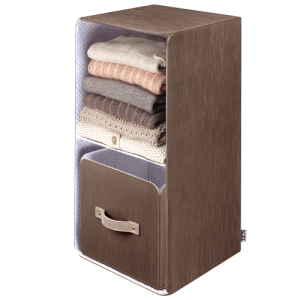 The central shelf has a 15 pound capacity; the unit measures 24″ H x 12″ W x 12″ D.
The central shelf has a 15 pound capacity; the unit measures 24″ H x 12″ W x 12″ D.
SOFI products seemed sturdy enough, from the cursory glance I got at the crowded NAPO Expo. However, if you have roughhousing tiny humans (or pets) intent on putting these storage items through their paces, you might want to add pieces slowly and review how your more wackadoodle household members deal with them.
The main drawback I see with SOFI, and this is certainly subjective, is that the line currently comes in a very drab, manly, retro brown, recalling the panelling in my parents’ 1970s living room, and the interior blue and white pattern doesn’t provoke much fashionista excitement, either. SOFI’s tag line is “So functional. So fashionable.” I’d agree to the former, but am unpersuaded as to the latter.
SOFI products are sold at Amazon, Staples, Office Depot, Wal-Mart and Target, and other retailers, with prices ranging from $10-$30.
Check out the video of SOFI in action.
Origami and SOFI were just two household organizing products to make their debut at this year’s NAPO Expo. Later in this recap series, we’ll revisit some old favorites to see what new tricks they had on display. Until then, make sure you haven’t missed some of the prior posts in this series:
NAPO 2015: Conference By the (Organizing) Books
NAPO 2015: PhD in Productivity at the College of Organizing Knowledge
NEET & Cozy Cables: A NAPO 2015 EXPO Organizers’ Choice Award Winner
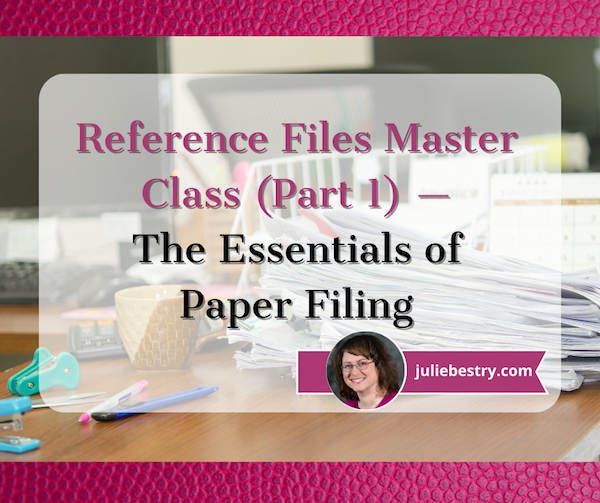

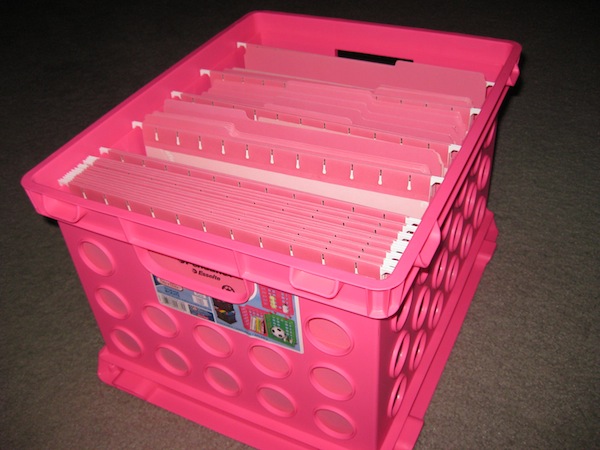



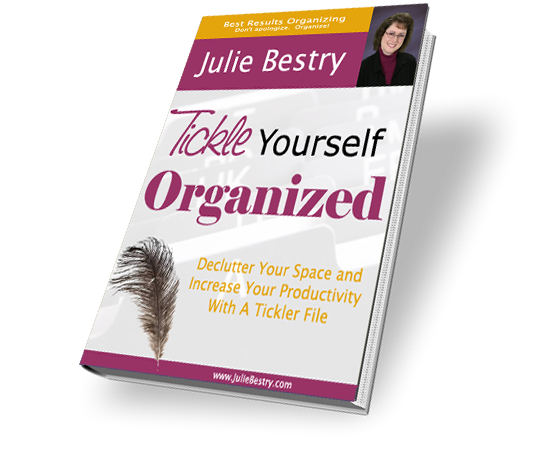









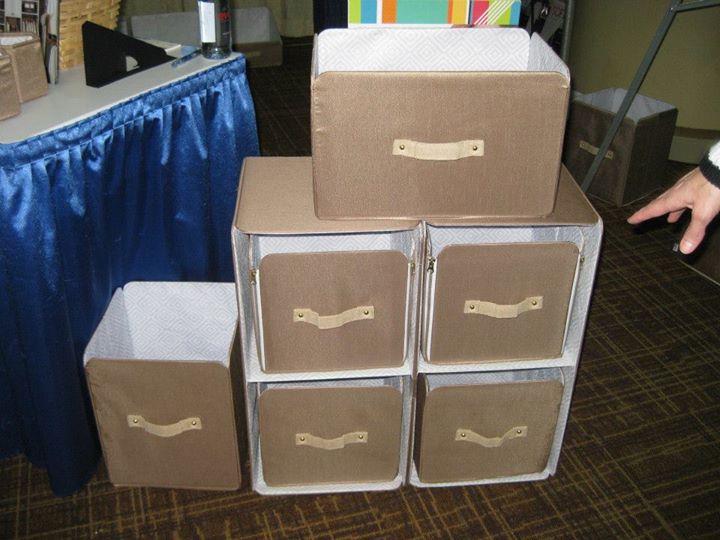
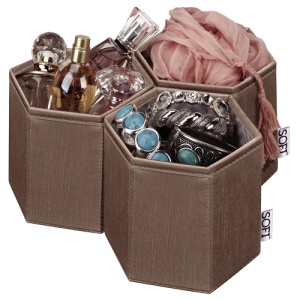
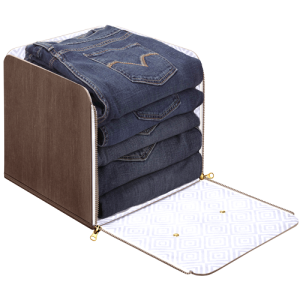
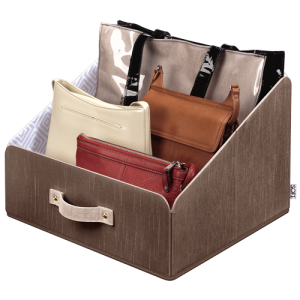
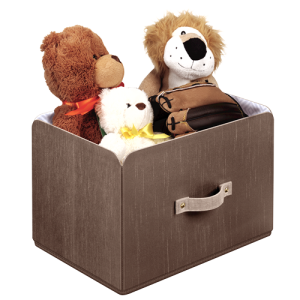
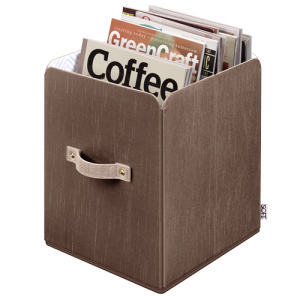
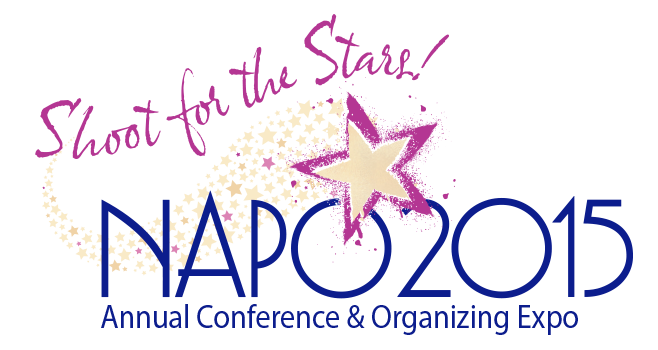



Follow Me